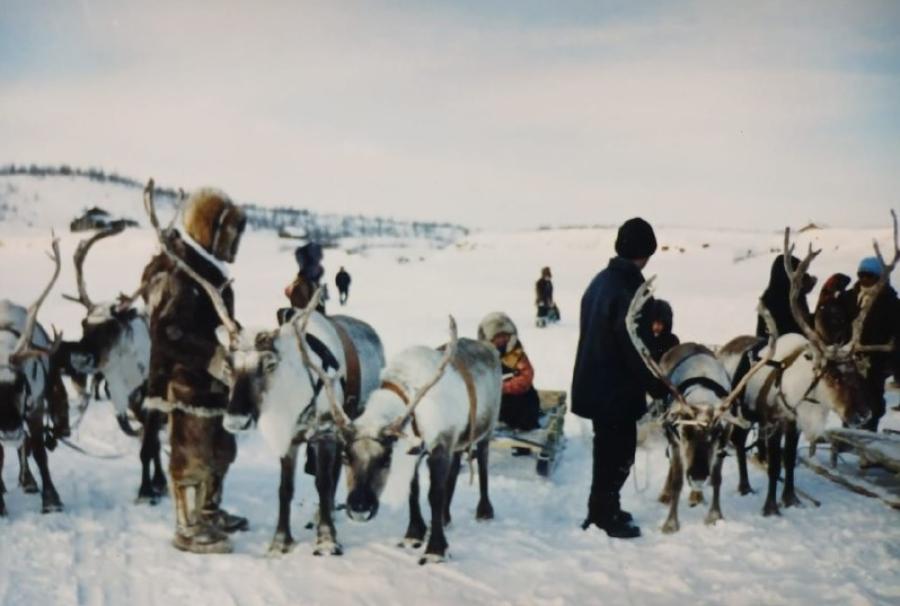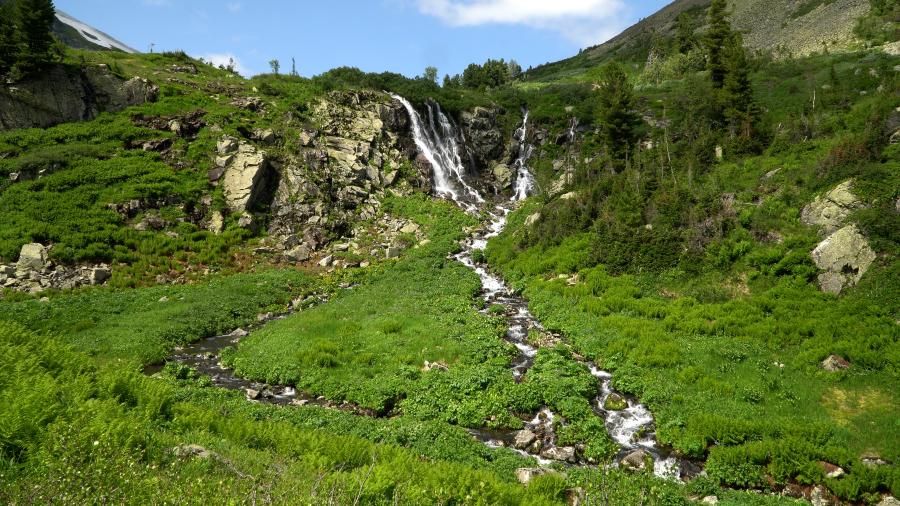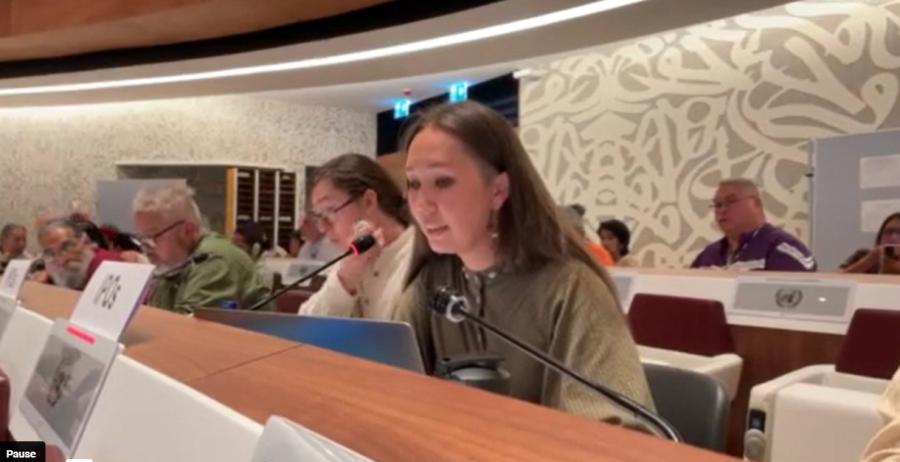For 10 months of each year, the three remote villages in the eastern Sayan mountains of south Siberia where the 731 members of the Tofa Nation live are accessible only by helicopter or small 1950s vintage bi-planes. In the dead of winter, visitors can drive along frozen rivers in an all-terrain truck to reach the villages. The Tofas’ extreme isolation has proved to be both a hardship and a benefit as they struggle with the impending loss of their language.
While the Tofa language is unlikely to be saved, their dilemma may be instructive to other peoples facing the pressures of globalization by illustrating precisely what is in danger of being lost when a language (and associated way of life) goes extinct. For many of the world’s indigenous peoples, cultural survival will be increasingly linked to linguistic survival. (See Cultural Survival Quarterly 25:2) For cultures like the Tofa that lack a written tradition, spoken language serves as the primary way to transmit cultural knowledge. This knowledge guides vital decisions of everyday life: showing people what wild plants to eat or use for medicine, from what clan to select a spouse, to what mountain they must make ritual offerings of food, during what month they should hunt squirrels, and what reindeer in the herd they can milk or ride. The intellectual wealth possessed by indigenous peoples consists of elaborate interlocking systems of knowledge about society, nature, ecology, and the invisible and visible worlds. These systems in turn depend on the vitality of the language for their continued existence. As indigenous languages disappear, most speakers will not manage to transport this vast storehouse of ancestral knowledge into the new, dominant language. They will lose an intricate knowledge base, including names for objects, myths, religious beliefs, and technologies such as animal domestication, ethnobotany, and sound mimesis. Dominant world languages (such as Spanish, Mandarin, and English) that indigenous communities are now embracing lack this special adaptation to local environments.
Language endangerment is a global problem. Of the estimated 6,000 languages now spoken around the world, nearly half, by current best estimates, will become extinct during the 21st century. Dying languages pose a particular challenge to linguists and scientists who must document them before they vanish.
Lost Lexicons and Songs
Although many Tofa still call Tofa their Native tongue, few report they can speak it. Fluent speakers make up a tiny number: As of June 2001, about nine persons in Aligdzher village, all 50 years or older, were fluent. Nerxa village had just five speakers, all elderly. A number of Tofa who were 40-years-old or older claimed some understanding of the language. No one under 30 claimed any knowledge of Tofa. One village school was closed in 2000 due to lack of resources and children now attend Russian boarding schools hundreds of miles from their Native communities. Boarding schools have typically constituted the final step in the loss of prestige and subsequent destruction of Siberian languages under Soviet, and now Russian, governance. Tofa is thus moribund, meaning that without children learning it as their first language the Tofa-speaking population will not be replenished as people grow old and die.
Even with so few speakers left, Tofa still shows some dialect diversity from one village to the next. It also possesses an archaic lexicon and grammatical structures that set it apart from its closest linguistic relatives (several Siberian languages spoken in neighboring regions on other sides of mountain ridges). Tofa contains many words that attest to an animistic worldview; for example, it has many words that indicate the bear and parts of the bear. Because the bear is both feared and sacred, a taboo prevents people from uttering its name out loud. It is properly called iresang, but is more likely to be named indirectly, for example as ulug ang (great beast), ulaktyg angast with ears), tuktug angfurry beast), or kara chume (black thing). Other words indicate bear blood, bear fat, bear paws, and bear skin. All these words are ancient; they reflect an earlier population of indigenous Siberians who were absorbed by the Tofa at an unknown date, and of whom few other cultural traces remain. But these specialized word structures are now collapsing under the influence of Russian, which has just one basic word for bear.
Herders and hunters of south Siberia, including the Tofa, possess highly specialized abilities for mimicking and stylizing the natural acoustic environment. These skills may confer an adaptive advantage by providing herders and hunter-gatherers a tool to manage wild animals, plants, and reindeer. Sound mimesis is manifested in hunting calls, animal-sound imitation, and more structured song and spoken forms. Some Tofa elders can perform various animal calls or play special birch-bark whistles to call wild pigs and musk deer, or birch-bark horns to call wild elk, but these skills are dying out.
Even fewer Tofa remember an ancient singing tradition. Employing a special vocal technique, a seemingly frail and soft-spoken 85-year-old Varvara Adamova, surprised a group of scientists in June 2001 with the power and resonance of her singing voice. She, along with her 75-year-old sister Galina Adamova, now deceased, were the only remaining inhabitants of Aligdzher Village who still sang in Tofa. The sisters sang dozens of songs during a week of recording sessions. Many of the songs described daily activities such as milking and herding reindeer that the sisters had practiced in their youth. Some had more metaphysical themes such as the bear cult,1 Tofa deities and spirits, and love and friendship. Curiously, all the songs were set to a single, unvarying melody, which community members said was common in all Tofa songs. Distinctive song styles of the three villages vary slightly in tempo or pitch, but all conform rigidly to the canonical motif. Could this culture possess just a single melody for all its songs? Is the melody an ancient Siberian tune? The answer may never be known.
Dying Language, Dwindling Herd
The decline of the Tofa language has occurred hand in hand with the decline in reindeer ecology. Specialized herding technologies encoded in the language (for example, elaborate systems for naming deer, complex animal domestication songs, and hunting calls) vanish as Tofa youth shift to exclusive use of Russian. In November 2001 a young Tofa reindeer herder named Mitya Amostayev, born in 1981 to the last remaining herding family, discussed the language as he saddled four reindeer at his house in Aligdzher village, preparing to ride for three days through the taiga to join his father and uncle at the herd’s winter grazing area. To Mitya, knowledge of the ancestral language seemed unimportant. “I don’t speak Tofa at all, not a single word. What for?” he remarked. The Tofa reindeer classifying system is complex; it takes into account age, sex, fertility, and rideability. Mitya did, in fact, know a few words for naming reindeer but he did not know their specialized meanings.
The village doctor, Raisa Kishteeva, born in 1957, drew an explicit parallel between the loss of language and the decline of reindeer herding. “Our children no longer know the taste of reindeer milk. Almost all the reindeer are gone now ... only a few are left. We sold some to the Soyots. We even sold some to the Yakuts—they were taken by helicopter, but not many survived because of the climate there. Our reindeer are not used to deep snow,” she lamented. “When I was a little girl, I used to go out to follow the reindeer herd with my grandmother. We would milk and care for the deer—reindeer milk was so plentiful then! We would sleep on the ground, on top of reindeer skins inside a teepee. We moved often to follow the herd. I spoke only Tofa with my grandmother. Nowadays I can’t even remember our language, only a few words.” It remains a question whether the loss of language and special words associated with reindeer ecology and herding led to a decline in the activities themselves, or whether, conversely, the decline of reindeer herding has led to the loss of the language as these words fall into disuse.
Pavel Ungushtaev, born in 1916, has seen the language loss as it has happened: “All our young people have been raised in Russian. They have forgotten Tofa,” he said. Artyom Kishteev, Raisa Kishteeva’s brother who was born in 1972, spoke for the younger generation: “I can understand when the old people speak Tofa, unless their teeth are missing. I know the words, but I can’t speak it myself.”
Repression of Tofa
Community elders remembered the repression of Tofa language during their youth. “The Tofa people were discriminated against, explained Spartak Kangaraev, born in 1930. “In the 1950s, old people were told not to come to the village shop wearing the traditional fur clothes. ‘Dress Russian, then come!’ they were told. We were also told not to be heard speaking Tofa around the village. In this way, we eventually stopped speaking our own language.” Prokopij Ungushtaev, born in 1938, confirmed that speaking and singing were discouraged: “[In the 1950s] there was an official order not to speak Tofa too much, only to speak Russian. There are many people who have forgotten it; they can’t speak, they can’t even sing.”
Other speakers recounted being punished in school for speaking Tofa. Konstantin Muhaev, born in 1948, recalled: “When I was a child they sent us to the village school. Lessons were in Russian only, and I couldn’t understand anything. I spent seven years in the first grade because I couldn’t learn Russian. The teacher was a Russian; he used to beat me when I couldn’t answer in Russian. In the mornings, he would test his stick to see if it was supple enough to hit us with.” Raisa Kishteeva, the village doctor, picked up on Russian sooner: “In kindergarten only Russian was taught, no Tofa,” Kishteeva remembered. “When I started kindergarten, my family still spoke Tofa at home. I used to speak only in Tofa with my grandparents. Kids like myself from the villages were sent to live in the boarding school. When we came home, we started speaking Russian.” Marta Kangaraeva, born in 1930, perhaps the most fluent living speaker of the Tofa language, can still recall when Tofa shamans were persecuted: “When I was a little girl I saw a shaman heal someone. After that they forbid it, they put shamans in jail. People who knew how to shamanize hid their drums and instruments in the rocks and mountains. They banned the shamans from the village—and they wrongly banned our language—that’s why the young people don’t know it now. It’s not their fault, it’s the fault of those fools in the government.” Shamans would have been the bearers of an important oral tradition that included songs, chants, ritual performance, drumming, and medicinal knowledge. They knew special words and phrases intended for ritual healing that ordinary speakers did not know. With the demise of shamans, an important part of the belief system as encoded in the language was lost.
Any hope for cultural survival now rests with those few bearers of the language and tradition who firmly intend to keep it alive. “Soon I’ll go berry-picking,” lamented Kangaraeva, known to everyone in the village as “Tyotya Marta” (Auntie Marta), using the colorful Tofa euphemism meaning “to die.” “And when I go, I’ll take the language with me.” But Marta’s son Sergei Kangaraev, an expert hunter and outdoorsman born in 1959, noted with great pride: “Of course I still keep the old customs. When I am out in the forest I always offer tea and food to the fire god for success in hunting. How could I not do it? And how could I forget my Native tongue?”
1. Common to many peoples across Eurasia, the bear cult is a ritualized veneration of the bear as a sacred animal, as evidenced in many taboos (both cultural and linguistic) associated with the animal.
Dr. K. David Harrison (dharris2@swarthmore .edu) teaches linguistics at Swarthmore College. He has been engaged since 1996 in research and fieldwork among nomadic peoples of south Siberia and western Mongolia, documenting their languages and cultures and studying the problem of language endangerment. This work is funded by a grant from the Volkswagen Stiftung. This article is based on two expeditions in November 2000 and June 2001 by Harrison, another linguist, an anthropologist, a musicologist, and a Native Siberian assistant. Part of the team’s mission was to document the Tofa language in digital video, photographs, and field notes, hoping to preserve valuable knowledge for future generations. The team also hoped to lay the groundwork for future field visits and community assistance.
References and further reading
Gibbs, W. Wayt. (2002, August). Saving Dying Languages. Scientific American, pp 78-85.
Harrison, K. David. (2001). Tofa. Encyclopedia of the World’s Minorities. Chicago: Fitzroy Dearborn.
Harrison, K. David & Whalen, Douglas (2000). The World’s disappearing and endangered languages. In Microsoft® Encarta® Online Encyclopedia.
Nettle, Daniel & Romaine S. (2000). Vanishing Voices. Oxford: Oxford University Press.
How the Earth Was Created
As of 2001, only a few elderly people were still able to sing songs or recite traditional stories. This creation myth is one example from the rich repertoire of Tofa legends, stories, and songs.
In the very beginning, there were no people. There was nothing at all. There was only the first duck, she was flying along. Having settled down for the night, the duck laid an egg. Then her egg broke, and the liquid of her egg poured out.



